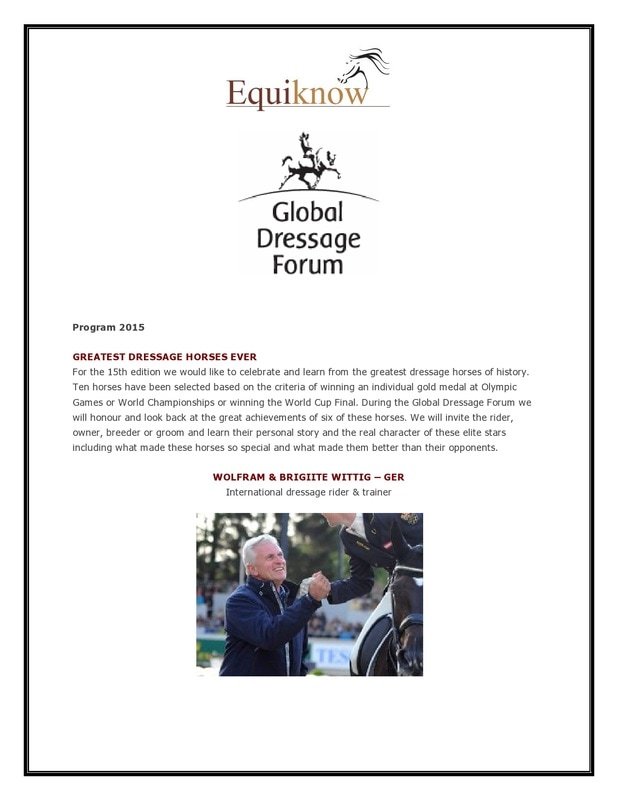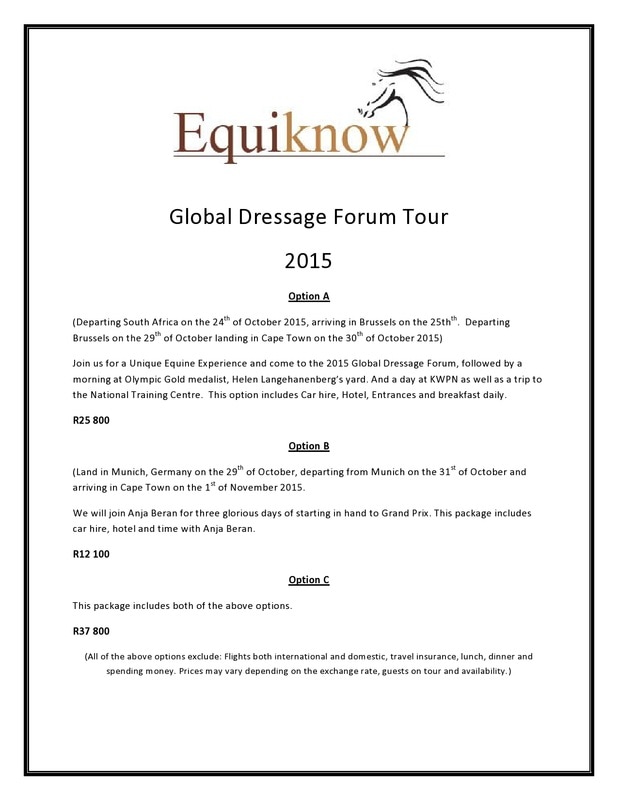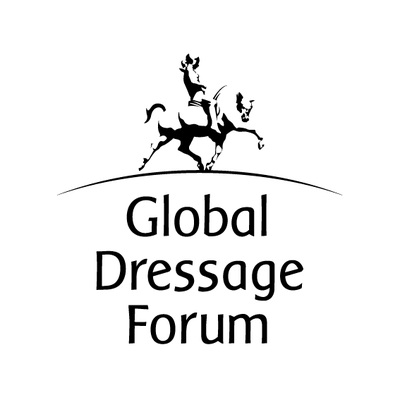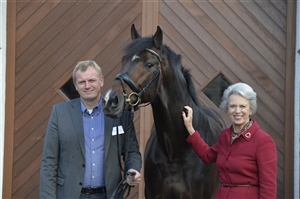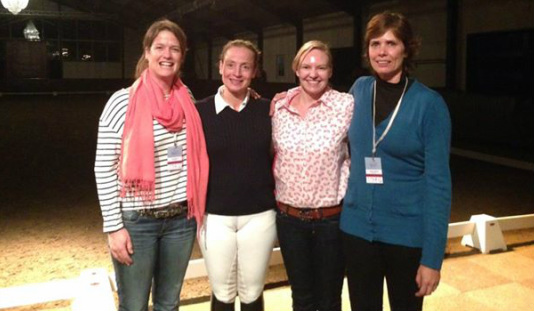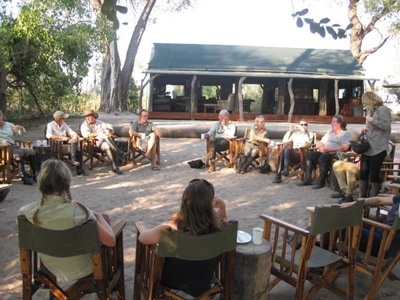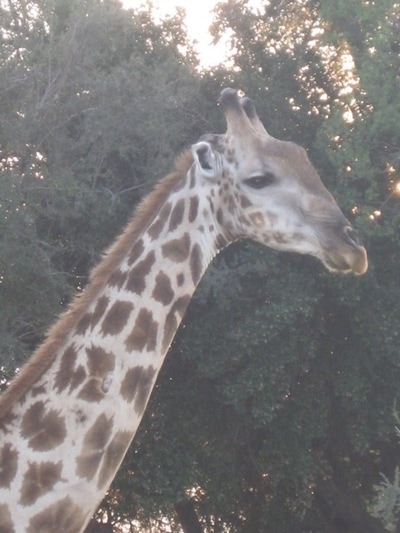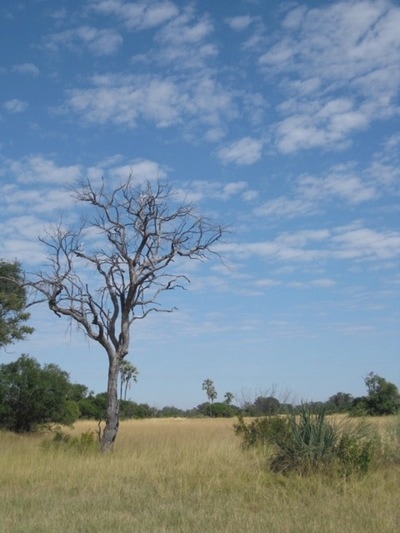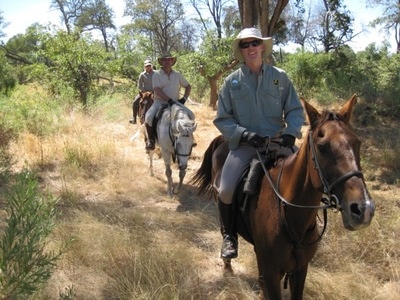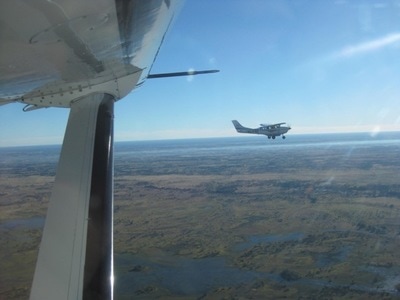|
Hans-Christian Matthiesen, international dressage judge and member of the FEI dressage committee, stepped in to deliver the FEI report on behalf of Trond Asmyr who was unable to attend. Despite the very short notice he very professionally took the audience through the work of the dressage committee and the many proposals of rules which lead to a very interesting discussion about the future of dressage engaging many different representatives in the audience. The internationally successful Dutch rider Adelinde Cornelissen has previously presented her own training as an athlete at the GDF. This time she demonstrated her training methods with the talented stallion Aquido. “Riding in these new surroundings I get a lot of information from my horse”. She talked the audience through her training while also speaking about her 17-year-old super star: “As long as Parzival enjoys it, he will be in the business”. After her demonstration Adelinde talked about the inspiration he gets from people even outside the dressage scene, like driver Boyd Excell, and openly answered questions both from a panel of professionals and from the audience – about nearly everything. The 14th GDF has kicked off For the first time ever the Global Dressage Forum is taking place outside The Netherlands - at the outstanding facilities at the Blue Hors Stud in Denmark where the Forum has kicked off today The 14th Global Dressage Forum has kicked off with a fabulous first day Monday 20 October. In his opening speech Richard Davison stressed that the 14th Global Dressage Forum is a very special one as it for the first time ever takes place outside the founders, Bartels Academy in the Netherlands. He praised the wonderful facilities and extended his gratitude to Keld Kirk Kristiansen, Esben Møller, Christian Struck and their team from Blue Hors for the enormous amount of work put into the preparations of the Forum 2014. The president of the Global Dressage Foundation, Her Royal Highness Princess Benedikte expressed a warm welcome to everyone attending the Forum and expressed the Foundation's gratitude for the huge efforts undertaken at Blue Hors. Giving the floor to the speakers the Princess said: "There should always be room for improvement; therefore critisim should never be taken negatively but turned into development." Lisa Lazarus, FEI Chief of Business Development & Strategy, had a very interesting discussion with Gerrit Jan Swinkels from Indoor Brabant and Martin Richenhagen from Fendt about the challenge of finding the balance between tradition and innovation in the development of dressage. A discussion where also capacities like Kyra Kirklund and Dr. Bechtolsheimer as well as many others paid their contribution on how to develop the sport on the horses' terms. As Andrew McLean put it in his presentation: "The Global Dressage Forum is a think-tank where we toss ideas around and value others’ opinion." Richard Davison spoke to the reigning world champion Charlotte Dujardin about her incredible life story from being a pony show rider to claiming 46 Grand Prix wins including all the big championship titles and world records in a matter of only three years. What really changed Charlotte’s career was when she met Carl Hester who taught her so much and of whom she speaks so fondly: “He brings so much fun to the sport and to my everyday.” However, it has been a bit of a bumpy road and the biggest challenge in Charlotte’s career was facing the media. “In the beginning of my career the press and the media were my worst night mare. They just scared me to death.” With time and experience she has overcome her fear of the press, and tonight she clearly enjoyed to speak at the Forum and to share her gripping story. Gina Capellmann and Fabienne Lütkemeier were last on the floor on the first day of the 14th Global Dressage Forum. Richard Davison spoke to Gina about coming from a dressage family and about her and her daughter’s career. It was clear to everyone that Gina invests herself 100% in Fabienne’s training. “I have no nerves when I compete, but when my daughter competes I get so nervous!” After an interesting interview the curtain opened to a most inspiring and very harmonious training session with mother and daughter. Fabienne schooled two horses while Gina explained about their ways of working. “I have been watching the stars warm up since I was a child, and I loved to see how they worked their horses” Fabienne said, and it was clear to everyone that she successfully has picked up the best from everyone. Second and final day at the Forum The 14th Global Dressage Forum has taken place at the beautiful premises of Blue Hors where everyone has been very well looked after. Today was the second day of a thought-provoking and an inspring two-day-programme This morning the audience were literally blown away by three para dressage riders who not only shared their life stories but also demonstrated their amazing skills in the saddle. In a practical demonstration the three superstars, British Sophie Wells and Danish riders Stinna Tange and Annika Lykke Risum talked about overcoming challenges in terms of compensating for their missing aids - and focus on the abilities they have, rather than focus on their disabilities. They expressed their regret about para dressage not being on the programme at the European Championships in Aachen next year. At the end of the Forum, the President of the Global Dressage Foundation, Her Royal Highness Princess Benedikte expressed her wish to help this discipline be part of the European Championships again - which immediately caused a firm applause form the audience. The Princess phrased a plea to the organisers of the championships: "Participants in the 14th Global Dressage Forum strongly recommend the organisers of the European Championships in Aachen 2015 to include Para-equestrian in the programme as one of the disciplines." The question of harmony was reviewed by former international dressage judge Jytte Lemkow through a slideshow of various photos of rider-and-horse combinations to give us a better understanding of what is harmonious when it comes to the size of the rider compared to the horse, the rider's attire, the rider's position and the horse's gaits etc. And all about harmony in dressage. Freestyle composers Joost Peters and Tom Hunt shared with the audience how they compose a freestyle taking into account the appearance and the personality of both hore and rider. International dressage judge Katrina Wüst joined in for a discussion about freestyles, and a panel comprised of top riders Beatrice Ferrer-Salad, Charlotte Dujardin and Nathalie zu Say-Wittgenstein shared their experiences and their preferences in freestyles. International dressage rider and trainer, Florida-based Danish Lars Petersen who is the former head rider at Blue Hors, made a practical demonstration with some of the Blue Hors riders and their quality horses at different training levels. Allan Grøn showed 4-year-old stallion Blue Hors First Choice by Jazz/Negro and 6-year-old Zick Flower by Zack/Romanov, whilst Maria Anita Andersen showed the 12-year-old mare Loxana by Diamond Hit/Argentinus. After the clinic Lars Petersen got the opportunity to explain into detail some of his techniques, and the panel of professionals acknowledged the good riding and the high quality of horses. Kyra Kyrklund and Richard Davison praised the clinic for being a lovely and down-to-earth practical demonstration in horsemanship and training. What a fantastic trip we had...filled with Super Stars, fantastic shopping, lovely hotels, loads of information and some VERY Famous horses....
This is a fantastic project that Equiknow fully supports! We collect any tack old or new and Dr Parker and her team sell it to the people of Bizana. It is sold for a minimal fee and the funds raised are used to purchase vaccine for African Horse sickness. The tack is fitted for its new owner and the horses/ponies are all examined and vaccinated.
We feel that this is a fantastic project because it’s all about giving but not for free and educating. The people of this area and their Equine benefit hugely! Well done to Dr Parker and her team!!! Please feel free to bring tack and riding equipment to any and or all of our talks hosted throughout the year. Don’t hesitate to contact me if you have any questions What a fantastic trip this was! We arrived on the 24th of October 2013 fling into Brussels. We hopped into our little hire car and headed for Hilvarenbeek to our hotel St petrus. On the 25th we set of for Jop Van Uyters Stallion Barn. We saw some of the most amazing dressage stallions in Holland at the moment. Gribaldi tribute from Edward Gal to Joop Van Uyter once he had retired. Slightly dazed an don a complete high we headed on to one of Hollands many tack shops. It was amazing and we shopped till they closed at 9pm. On the morning of the 26th we set off for Stal Korenbloem in Weert for the Equine Elite Auction. We arrived at 11am in time to see the presentation of the horses for the auction. At 12:30 the stables opened for viewing. The horses ranged from 2 years old to Grand Prix circuit campaigners. This was followed by a wonderful dinner of sushi, champagne on tap and the hugest buffet you have ever seen. The auction opened at 6:30pm.it was fantastic to see and they really do put on a great show of dancers, singers and fireworks. The attire is extremely smart. Luckily we had a tip off and managed to find some glad rags. The horses were great and prices ranged from 20 000 Euros to 350 000 Euros. We left at about 12pm tired and happy. On the morning of the 27th we got up early again and set off to a local show. We watched about 35 PSG horses compete. It was great to see non professional riders of different abilities on horses of all different sizes, shapes and quality. It made us realize that we are not that far behind and that our level isn't much lower. The biggest difference being that the number of competitors in Holland is much greater and the depth of riders is much bigger. Obviously we are limited at Grand Prix level but as we only started competing GP as a country recently it holds great promise of things to come for South Africa. As long as we continue to grow with initiatives like GGP and horses of high quality keep being imported into South Africa we will continue to improve as a nation. After the show we set off for Academy Bartels for a guided tour by none other than Tineke Bartels herself. What an amazing person. So humble, open and knowledgeable! We ended our tour with coffee and a short video. What a treat! The 28th saw the start of the Global Dressage Forum. We arrived at the Bartels at least 3 hours early. This allowed us time to shop and make sure we got the seats we wanted. The stalls at the forum are great and filed with lovely equestrian attire, equipment and very interesting information ie cloning, aqua treadmills. We all loved the dressage simulator but sadly we weren't brave enough to ride the horse in front of the likes of Isabell Werth and Edward Gal. We will have to try next year. RIchard Davidson is such a fantastic presenter and really interviews well. He opened the forum after HRH Pirncess Benedict had cut the ribbon thereby opening the new state sponsored indoor at Academy Bartels. First up we had Troyd Asmyr who is head of the FEI. He spoke about numerous topics including rule changes, arena stewards, the Olympic Games and development of the sport. This made us think long and hard about Dressage in South Africa. Who plans the development of the sport, who decided what happens when and how? I think that we HAVE to start working together as a country and not continue running each province as a separate unit. We have to think in a unified way in order to develop dressage within the country and stop arguing over who hosts what show and whats fair and what's not. At the Global Dressage Forum there were numerous ideas that were initiated by riders, trainers and judges alike that the FEI have instantly taken on board. All with the main idea of developing and improving the sport of dressage world wide and its only though working together like this that we can improve and grow the sport. The next speaker was Jan Dierens who spoke to us about the mental aspect of dressage. He is a sports psychologist who is working with the Dutch team and fascinated us with some visualization techniques and much more. Then came the winning machine-Isabell Werth. She showed us what her riders do on her horses daily. She has 6 yr old and an 8 yr old to show us. Then Jose her Spanish in hand trainer showed us what he does to train the piaffe and passage. Then Stephen Clarke introduced Katrina Werth.and a German rider who is also a judge and computer programmer and is only 25 yrs old. They showed us an app that they have designed for writing your Kurs. Once you have designed it on the computer you email it to the show office and then the judge has a copy of your individual Kur. This makes judging much easier, quicker and more fair. The scores are calculated b the program and marks are out instantly. The FEI is very excited and are going to buy the app. After dinner we had a brief talk by the organizers of the World Equestrian Games in France. Then it was again the turn of Isabell Werth. This time she sat on a couch with Richard Davidson and they chatted over some wine. She spoke openly about her drug charges and her life as a top competitor, trainer and mother. She then introduced onto the stage her wonderful owner Madeleine Winter-Schulze. They spoke together about their partnership, trials and tribulations in the world of dressage at the top. Isabell then got onto Don Johnson and let us watch her ride while she and her trainer Monika Theodurescu talked about their daily work routine for this spectacular and life filled horse. Whom she said she hopes will one day show the judges what he can really do. And boy did he show is that night! Watching Isabell Werth was fantastic! She is truly and incredible horse woman who has so much to offer in the skill and feel of training horses. We were watching a true master at work! We went home absolutely elated and exhausted! Day 2 started with Marianne Sloet who is a Professor of veterinary science. She spoke about emerging diseases like west nile, infectious anaemia and African Horse sickness. Wim Ernes followed with an AMAZING talk about how to choose a Grand Prix horse when its only a foal. ANd what to look for at each stage of purchase if intending to compete at GP. He was accompanied by Tim Coomans, Joop van Uyter and Nico Witte. As a surpise Richard Davidson selected Esben Muller of the Blue Hors stud in Denmark from the audience to verify if what they were saying was what he also believed. This made it very interesting to have four of the top breeders in Europe debating confirmations, breeding and movement. They all agreed that here are 6 steps to success: (in no particular order) 1. Pedigree 2. Confirmation, movement and soundness 3. Character, temprement 4. Education and training 5. Management and facilities 6. Preperation for competition management They started by showing us 2 weanlings and each pointed out what they felt was so impressive and or not impressive about each one. The Nicco WItte showed us a 2 yr old colt of his. Joop van Uyter showed us a very different 2 yr old colt of him and both justified why they felt each would get to the top even though they were so different. Then Tineke and Imke had their day as riders and trainers. We then saw a 3 yr old stallion being ridden call Ferdo. He was licensed this year in Holland. Tim Coomans then showed us one of his 3 yr old mares. She got 85% at the inspections and was therefore an elite mare. The four year olds looked amazing and we finished off with two 5 year old stallions. One a late developer and one at a very advanced level already. One was Easy Game and the other was Dream Boy. Again this sparked debates. Richard Davidson then opened the floor for some very interesting questions. After lunch we had a lovely demo form Jan Brink and Kyra Kurkland as to how they are developing the sport of dressage in Sweden. They then each taught their pupil and spoke about how they got heir program sponsored and to where it is today. In closing it was announced that The Global Dressage Forum 2014 will be held in Denmark at Blue Hors Stud...Denmark here we come. The following day we set off for RIen van Der Schafts hoem and yard for two nights. Watching Rien , his wife Ingrid and daughter train together as a family was really special. We learnt a lot and appreciate just how lucky we are to have a man of his caliber and ability coming to South Africa to train our riders! Watch this space for details about next years trip to Denmark!
Iridology was used by the ancient Egyptians, classical Greeks, and throughout Europe since the 9th century. Iris mapping was advanced in the late 1800’s by the studies of Dr.Ignatz von Peczely. In the 1st World War Dr. Stephenson, a veterinary surgeon, and his young assistant Syd Mercer worked together in the remount section, and they took particularly note of the markings in eyes of the injured, diseased and dying horses.Later in life, Syd Mercer became known as the “Magic Man” in the horse racing world, as he reputably helped several racehorses win major listed races. Syd Mercer would carefully study a horse’s eyes before prescribing remedies for it, many of them being herbal, and he became in all likelihood the first recognised equine iridologist. There is an intricate link between the eye and the brain via the nervous system, and iris nerve cells record vibratory changes in the rest of the body and respond to tissue changes. Iris markings include dark marks, white marks, stress lines–(which look like deep cuts), lactic acid lines (which look like brush markings) and radii solari which are raised ridges on the iris. Iridology can show what is happening inside the body non-invasively, and give warning to potential illnesses or lameness as it can show where the body is under either systemic or muscular-skeletal stress. It can also show if there are inherited strengths and weaknesses, and explain behaviour problems. It will not show pregnancy, as that is a completely natural process for the body, and it will not necessarily show operations (such as gelding) as the anaesthetics cut off the telepathic recordings of the nerves. Iridology combines extremely well with herbalism, as besides their nutritive properties, herbs also have medicinal properties (such as circulatory stimulants, demulcents, liver supportives {hepatics} diuretics, nerve tonics, anti-inflammatories, cell proliferants, etc, etc…) which detoxify and support the body to speed the healing process. By allowing the body to thoroughly heal itself with the aid of herbs (rather than using conventional anti-inflammatories and antibiotics, etc, which will only suppress the symptoms temporarily, but do not actually stimulate the healing process) it helps to ensure against recurring illnesses and injuries. Herbs can also be used as a preventative medicine, which is especially useful for horses which show inherited weaknesses. This has become a mine field and a rather off putting factor when buying a horse. In my research for this article I was told that a commission is due to you when you:
make a phone call
I have been involved in the sale of a horse on behalf of a client of mine when the prospective buyer took 10% off the asking price on behalf of her coach (who didn’t even come to see the horse) because this is their arrangement. In the sale of property the commission goes to the estate agent who sells the house to the new owner. In order to receive that commission the estate agent has met the client either through a show house or a newspaper property advert. Often an estate agent will offer a finder’s fee either for the person who finds the seller, or the buyer of the property. This is at the discretion of the estate agent. I feel that a standard agreement should be set amongst horse owners, buyers and or sellers. A standard 10% commission is due to the person who takes you the buyer to see the horse that you buy. Be they your coach, mentor, or rider. As they have found the horse and taken the time out of their day to go and show it to you. If your coach comes along to advise you then they are not due a commission. IF the person who found the horse chooses to share their commission with your coach, then that’s their choice. This I see, as a coach, as part of your commitment to your client. You should be advising your client to buy the horse that’s best suited to them and not the horse that’s best suited to your bank balance due to the commission attached to that horse. I feel the most important advice for coaches, riders, owners and dealers is to be up front with people. And to be clear with them. A prospective buyer needs to ask up front of everyone involved in the sale of the horse-which is getting commission and what is the commission Likewise a coach who is spending a huge amount of time travelling around the country looking at heaps of horses needs to say that their costs must be covered and weather they expect commission or not. And a seller needs to tell anyone who enquires about their horse weather a 10% commission is included or not. If it’s not included I think it’s very important to remember to state that no more than 10% commission should be added to the price. This is another area where people get greedy and put on 20-40% commission which results in the horse not selling. People then wonder why it’s been on the market for so long and don’t look at it because they presume that there must be something wrong with it. In the mean times it hasn’t sold because someone got greedy! TO recap: Whether you’re a buyer, seller, coach or owner be upfront about whether the commission is included or excluded. State how much you will allow the commission to be (10% being standard) and discuss openly who the commission is going to be paid to.
Now we had a clear, level site on which we had rolled and compacted 150mm of laterite base coarse. Enclosed it with treated scaffolding planks. The arena was ready for some sand. This I was lucky enough to source in Wolseley. Once transport was arranged it was delivered and we spread it by hand. This was back breaking work. The sand was spread at a 100mm depth across the arena.
Then I rode on it like this for a few months. The arena settled and I managed to save the funds needed to buy the fabulous fibre from Torque earth. It was a very exciting day when 12 bales of fibre arrived on the farm. Each bale weights approximately 350kg. So we again divided the arenas into squares. We loaded the bales onto the tractor and then drove them onto the arena pushing one off into each demarcated square. We opened the bales and spread the fibre in 40’ heat. It was hard work! Once evenly spread by hand we then wet the arena thoroughly. We borrowed a rotovator from our very kind neighbor. This mixes the sand and fibre. We then used our tractor and kongskilde to mix in the damp fibre and sand even further. I then hired a 2.5 ton roller to level and compact the surface. By this time I was exhausted! After a good night’s rest I was very excited and nervous to test the arenas surface. It was and still is amazing! The horses travel on top of the surface instead of into and out of the sand. For those who think that having kids tests your marriage-try building an arena! I guess my husband would say if you think marriage is hard trying being married to an Equestrian! Thank you to Peter and his team at Torque earth, my neighbor, my husband and my team of guys. |





